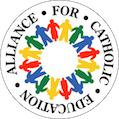Written by: Caroline Lang
Amazing people all over the country are changing the lives of students in Catholic schools every day. Teachers, administrators, parents, and supporters of Catholic schools work tirelessly to provide every child a quality education. While it’s not possible to tell every story, and give every person the recognition he or she deserves, the 20 Catholic School Stories You Should Know series will help tell some of the best, most heartwarming, most life-changing stories about simple people doing extraordinary things for the cause of Catholic education.
What better way to kick of the 20 Catholic School Stories You Should Know series than by telling the story of St. Elizabeth Ann Seton, the founder of Catholic schools in America. Her story is truly the first Catholic school story, and the one without which none of the others would be possible.
-------------------------
"The kingdom of heaven is like a mustard seed, which a man took and planted in his field. Though it is the smallest of all seeds, yet when it grows, it is the largest of garden plants and becomes a tree, so that the birds come and perch in its branches.” Mt 13:31-32
Every great and mighty tree, like every great endeavor, begins as a single seed, requiring care and nurturing to reach its full potential.
Before 1634, the fields in which to plant the seeds of faith in the New World were largely fenced off to Catholics, and anti-Catholicism was official government policy in the English colonies. It wasn’t until Lord Baltimore founded Maryland as the first “non-denominational” colony that the seeds of Catholicism were able to take root in America.
Even after Lord Baltimore established a tolerant state, the Catholic seedlings weathered terrible treatment, constantly trampled by persecution and choked by legal restraint. This oppression lasted for more than a hundred years, until it was largely mollified by the French involvement in the American Revolution, and a respect for their culture and Catholic identity developed.
This new respect largely cleared the skies for Catholicism and turned over a new leaf for its potential to grow, given the proper attention and caretakers.
Elizabeth Ann Seton became one such caretaker, sowing new seeds and meticulously cultivating the great tree of American Catholicism.
A convert to Catholicism, Elizabeth was confirmed into the faith by the Right Reverend John Carroll, the first and only Catholic bishop in America at that time. Elizabeth then founded an academy for young women, but enrollment numbers dwindled as news of her conversion to Catholicism spread, as anti-Catholicism was still prevalent.
During this troubling time, Elizabeth sought the spiritual counsel of a visiting priest, the Abbé Louis Dubourg, a French émigré of the Society of Saint-Sulpice. The Sulpicians were in the process of establishing the first Catholic seminary in the United States, and Dubourg invited Elizabeth to join them in their mission in Emmitsburg, Md.
A year later in 1810, Elizabeth established the St. Joseph’s Academy and Free School dedicated to the education of young Catholic women and made possible by the financial support of Samuel Sutherland Cooper, a wealthy convert and seminarian at the newly established, nearby Mount Saint Mary's University.
Around this time, Elizabeth also founded the first congregation of religious sisters in the United States, the Sisters of Charity of St. Joseph’s, which was dedicated to the care of the children of the poor.
Mother Seton, as she was henceforth known, dedicated the rest of her life to nurturing Catholic education in America, knowing that instilling the seeds of faith in the nation’s youth was the best way to cultivate the Church in America.
Pope Paul VI officially canonized Mother Seton on Sept. 14, 1975, making her the first native-born American saint.
The branches of Elizabeth Ann Seton’s legacy continue to grow and extend their reach over American Catholicism today. St. Elizabeth Ann Seton is honored as the patron saint of Catholic schools for the tremendous impact she had in the nascence of American Catholic education. Not only does Mother Seton School still exist in Emmitsburg as a direct descendant of St. Joseph’s Academy and Free School, but six separate religious congregations also trace their roots back to her Sisters of Charity.
Directly or indirectly, Catholic schools from Los Angeles to New York, Seattle to Miami owe their success largely to Mother Seton, who tended so tirelessly to the seeds of Catholicism—and the even smaller mustard seed of Catholic education. Her efforts allowed them to take root and grow into the beautiful, fruitful trees of faith we continue to cultivate today in our nation’s Catholic schools.






